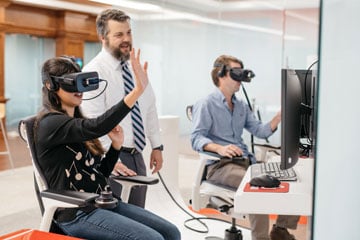
CHICAGO - Will lawyers soon be arguing their case in a virtual courtroom, perhaps from their living room or a distant tropical island, untethered by a physical location? While that may seem like a distant sci-fi future, virtual reality is no longer fiction, as some technologically savvy legal educators outlined in a panel discussion at the ABA Techshow in Chicago yesterday.

CHICAGO — Will lawyers soon be arguing their cases in a virtual courtroom, perhaps from their living room or a distant tropical island, untethered by a physical location? While that may seem like a distant sci-fi future, virtual reality is no longer fiction, as some technologically savvy legal educators outlined in a panel discussion at the ABA Techshow in Chicago yesterday.
Kenton Brice, a former trial lawyer and now director of technology innovation at the University of Oklahoma College of Law, spoke about several current practical ways VR is being used by lawyers. This includes presenting evidence in mediation and arbitration, such as a virtual reality simulation of a car accident.
“Really, VR opens up discovery or evidence presentation to a limitless degree. Before we had poster boards, then we had PowerPoint; now we will have this 3D content that we actually import into a courtroom,” he said.
Brice also outlined how VR can help create virtual models of crime scenes or relevant locations. With a $1,500 drone and some software, Brice said, a construction site was recreated for a case in a way that traditionally could only have been done by a developer for $60,000 to $70,000. The virtual model is also arguably more accurate than a rendering, since it based on video footage and more akin to a photograph than an illustration.
“We have been using photographs in the courtroom for years. it is the same idea. It is just wrapping your mind around this photo — instead of being flat, it is now textured,” said Brice.
Ayyoub Ajmi, who is the digital communications and learning initiatives librarian at the University of Missouri-Kansas City School of Law, uses 360-degree video as an instructional tool for law students. VR video allows students to simulate a courtroom in their trial advocacy class.
“By introducing a 360-camera, I can record the student as well as the jury,” says Ajmi. “When they get feedback on the video, they are able to watch both.”
Jennifer Wondracek, director of legal educational technology at UNT Dallas College of Law, is hoping to design a virtual courtroom for students.
“Like most law schools, we have a courtroom. I was walking past the courtroom one day and saw a line of students just waiting to use it and I thought there has to be better way.”
“My goal is to make it affordable for the law students, for the college moot court teams, the high school competition teams, the lawyers, even a 12-year-old who thinks ‘hey, I want to be a lawyer one day; what is it like in the courtroom?’”
Wondracek is pilot testing her virtual courtroom now, which she hopes will “give [law students] experience before the high-stakes, real-world situation.”
But for lawyers in practice today, VR may not be just a theoretical exercise. In addition to virtual models appearing as a tool for courtroom advocacy, Brice said 360-degree video that is posted on to YouTube or Facebook is finding its way into the discovery process. “Lawyers need to be cognizant of what this is and how to display it,” said Brice.
And, in the future, VR will no doubt continue to change how the legal profession tells stories.
“What if we put the entire jury in a headset, and then we had the entire jury exploring the trial or the crime scene themselves, untethered from someone else’s narrative?” asked Brice. “That leaves a lot of lawyers really uneasy, because lawyers love to have to construct their narrative. That is what trial is.”